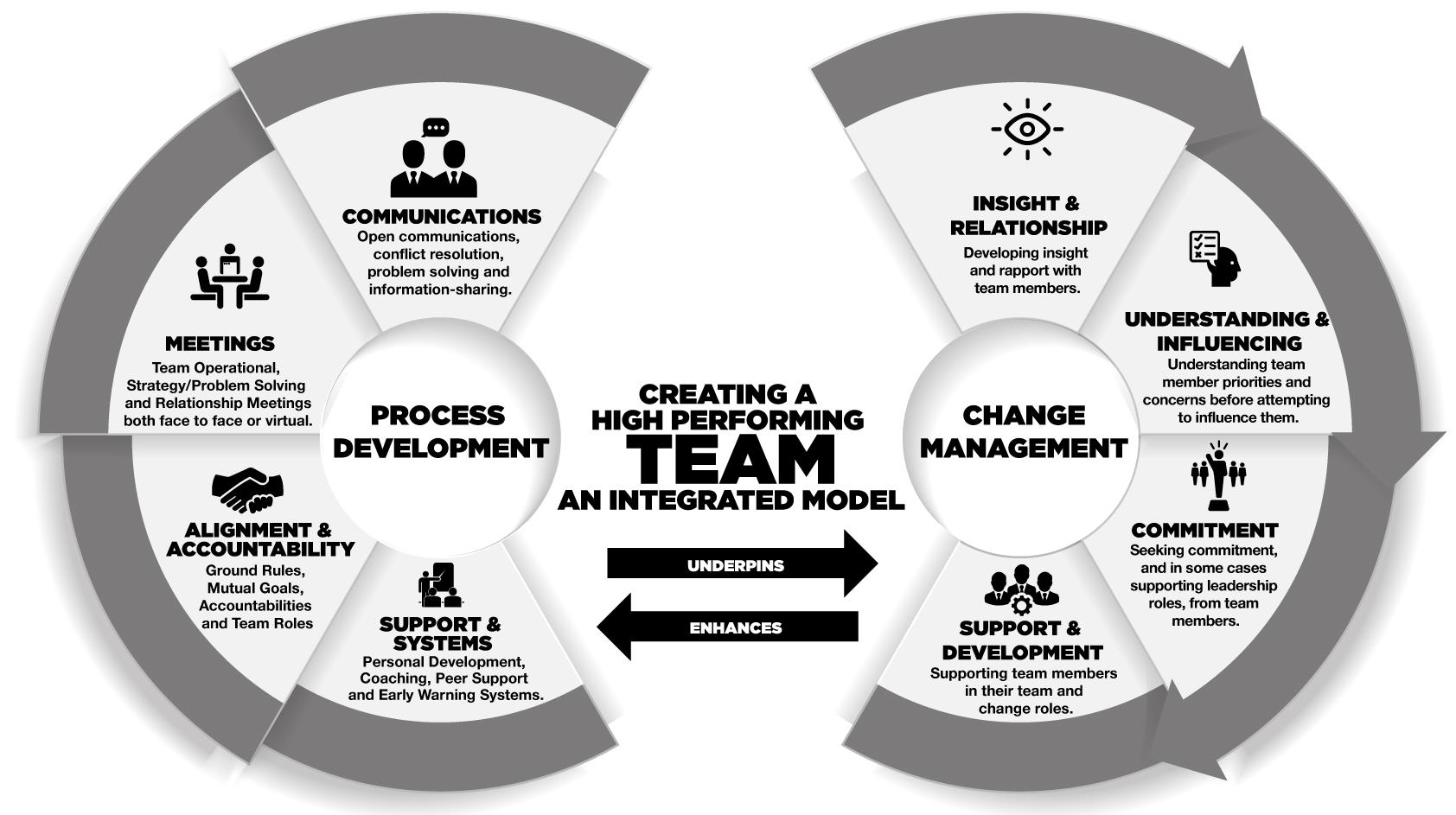White paper - The Racetrack Model for high-performing teams
By Ken Thompson, May 30, 2025 Last updated Aug 19, 2025
Summary
The Racetrack Model of high performing teams is a simple sustainable model for setting up any team for success. It recognises that creating a team is a hybrid project which requires you to concurrently do both change management and process development.
Contents
- Process development for the team
- Team meetings
- Team alignment & accountability
- Team communications
- Team support & systems
- Very important questions
- Team process grouping
- Summary
Process development for the team
From all the research and practical experience, there are 4 areas of process which seem to be fundamental to successful HPTs.
- Meetings
- Alignment and accountability
- Communications
- Support and systems
These areas are of broadly equal importance and can be thought of as 4 legs of a stool – if any one of them is deficient, the stool will be unstable and not fit for purpose.
We can expand each of these areas further into 16 specific processes / practices (4 per process area).

Team meetings
M1: Operational meetings
Ensure that team operational meetings are regular and effective.
M2: Strategy / problem-solving meetings
Ensure that strategy/problem solving meetings of the team are timely and effective.
M3: Relationship / trust meetings
Ensure that team meetings to build relationships/trust are timely and effective.
M4: Virtual meeting/phone meeting practices
Ensure that the team is able to conduct effective meetings in person or remotely/virtually.
Team alignment & accountability
A1: Team ground rules
Ensure that the team has defined what constitutes acceptable and unacceptable behaviours.
A2: Team goals & objectives
Ensure that the team has clearly defined and communicated mutual goals and agreed how changes to these are communicated.
A3: Team member accountabilities
Ensure that each team member has clearly defined accountabilities within the team.
A4: Team leadership roles
Ensure that, in addition to the team leader, the team enables supporting team leadership roles.
Team communications
C1: Open communications practices
Ensure that team members have an environment for openness with the team leader and their colleagues.
C2: Conflict resolution process
Ensure the team has processes to address interpersonal conflict quickly and effectively.
C3: Decision-making practices
Ensure the team uses recognised decision-making techniques appropriate to different situations.
C4: Information-sharing
Ensure that the team effectively shares accountabilities, priorities, updates and information.
Team support & systems
S1: Personal development
Ensure personal development is in place for team members.
S2: Coaching relationships
Ensure team leader(s) are regularly in coaching conversations with other team members.
S3: Peer support system
Ensure team members directly support and help each other through collaboration.
S4: Early warning system
Ensure team members keep a lookout for any risks which might impact other team members' ability to deliver their results.
Very important questions
There are 2 very important questions you need to address before you start attempting to implement these processes in a team.
Q1: How do you establish which processes are the most important for your HPT?
Q2: Are the process priorities the same for all HPTs?
Let me start with the second question first. All teams start in a different place of capability with respect to this team process framework. Your first job as a team leader/team builder is to conduct a team process “health check” of your team against the HPT process framework. This will establish, for each of the 16 processes, whether an existing process exists, to what extent it is being used and to what extent it is working. In section 5, I will share a useful free tool which can help you conduct such a health check.
So, as all teams start with a different process capability profile, you should generally prioritise those processes which are either absent or broken before you try to improve those which are already in place and working to varying degrees.
However, this is not the whole story as some team processes are more important than others. For example, if a regular team operational meeting is badly broken, this will damage a team every single week. Whereas, if a team relationship meeting is broken, this might only damage a team once a month or once a quarter.
Team process grouping
It is useful to group your team processes into 3 levels of team importance/maturity with the suggestion that you address the level 1 process issues before you address the level 2 process issues and so on.
Level 3
Advanced processes (7)
Level 2
Key processes (5)
Level 1
Foundation processes (4)
This will allow you to create “basecamps” of process maturity as you climb the HPT "mountain" and is good change management practice which you neglect at the risk of creating “improvement chaos” within your team.
In figure A, I suggest a practical sequence for improving the 16 team processes. Please bear in mind this is not intended to be prescriptive, but rather a guide.
For example, I suggest that, all else being equal, the 4 most important team processes to fix first are team operational meetings, team ground rules, open communications, and peer support system.

Summary
In team process development, you should first conduct a process health check on your team. Then, consider relative process importance to produce a process development plan for your team which is both appropriate to your team and reflective of best practice.
